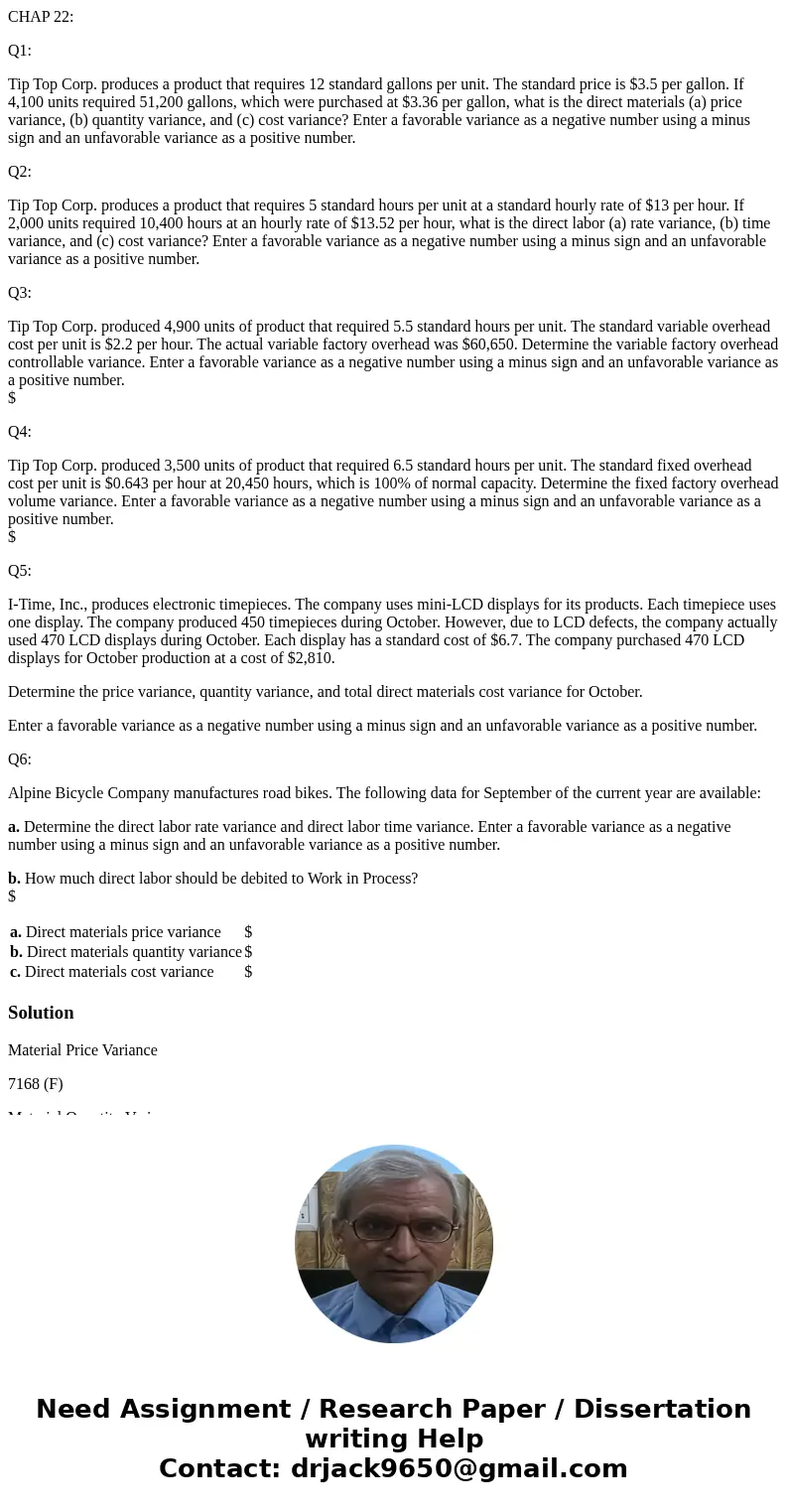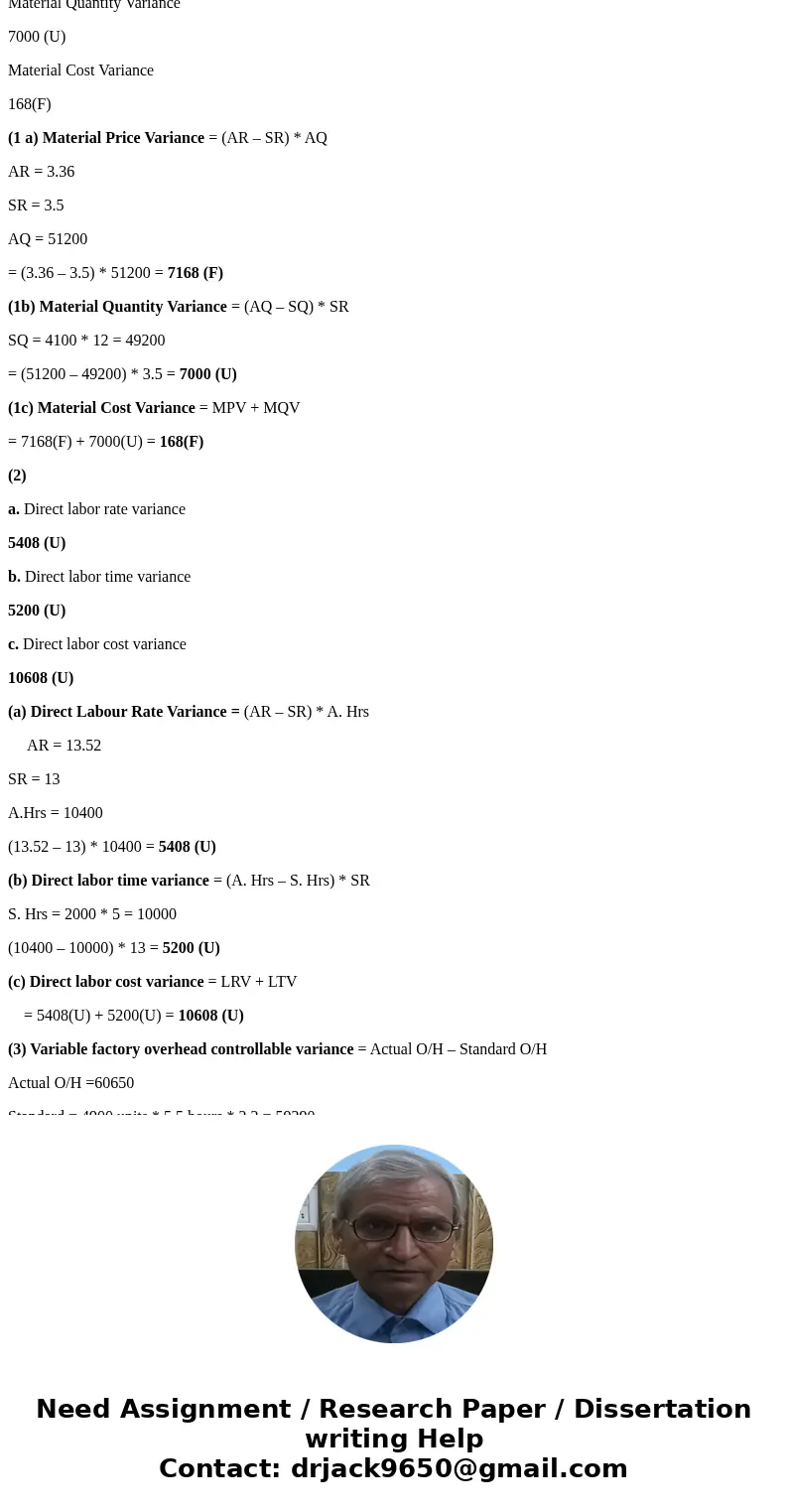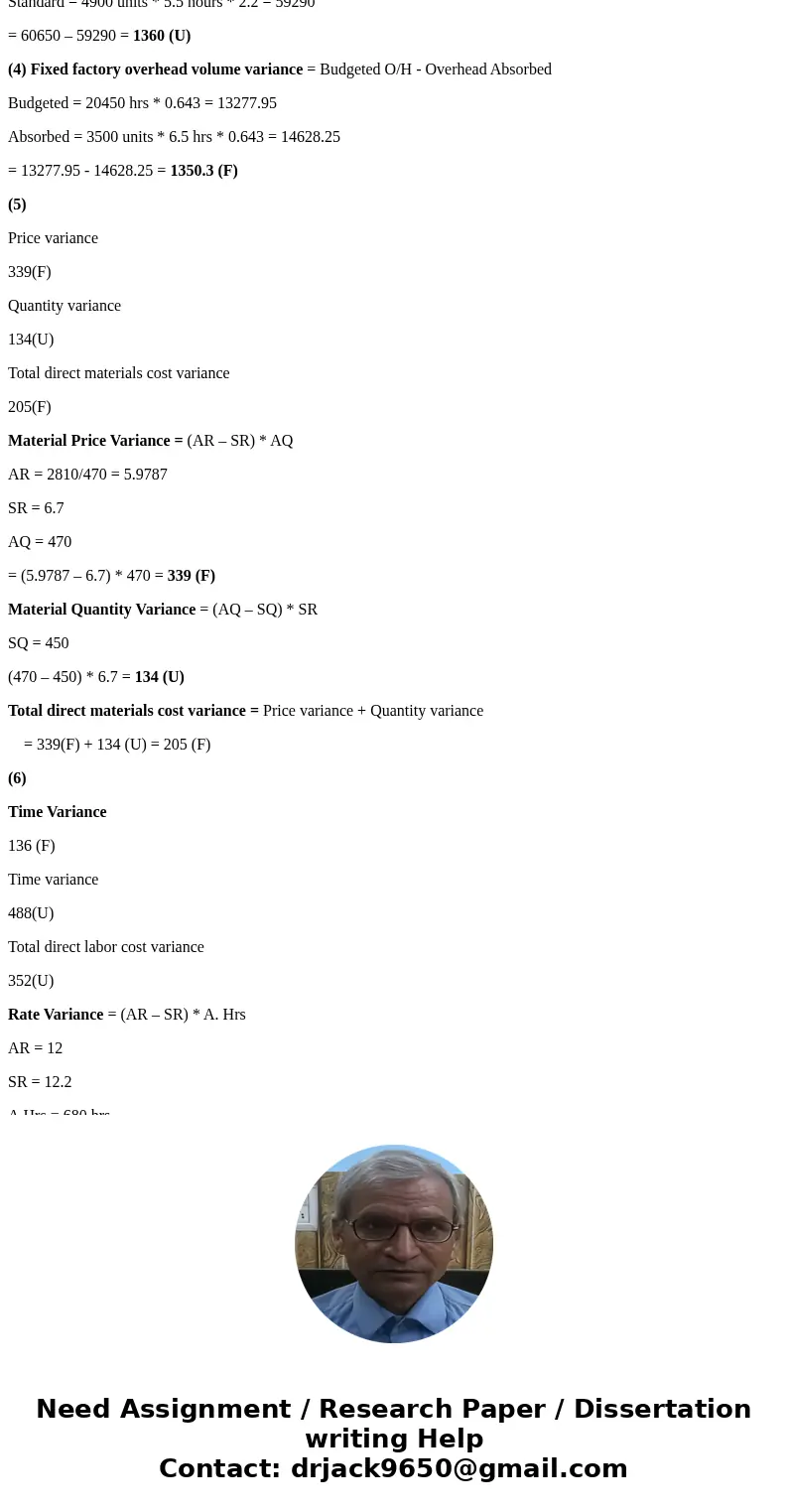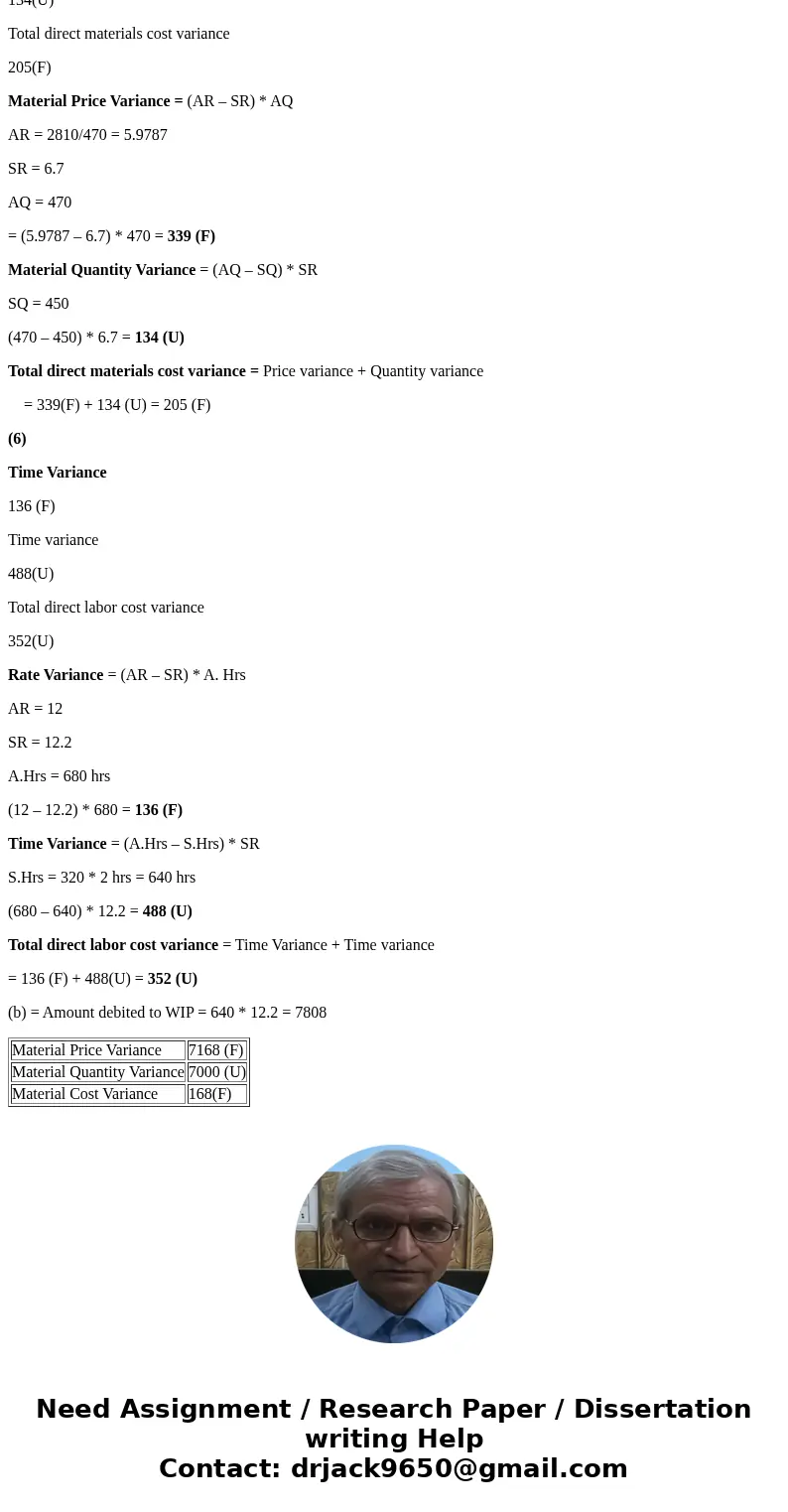CHAP 22 Q1 Tip Top Corp produces a product that requires 12
CHAP 22:
Q1:
Tip Top Corp. produces a product that requires 12 standard gallons per unit. The standard price is $3.5 per gallon. If 4,100 units required 51,200 gallons, which were purchased at $3.36 per gallon, what is the direct materials (a) price variance, (b) quantity variance, and (c) cost variance? Enter a favorable variance as a negative number using a minus sign and an unfavorable variance as a positive number.
Q2:
Tip Top Corp. produces a product that requires 5 standard hours per unit at a standard hourly rate of $13 per hour. If 2,000 units required 10,400 hours at an hourly rate of $13.52 per hour, what is the direct labor (a) rate variance, (b) time variance, and (c) cost variance? Enter a favorable variance as a negative number using a minus sign and an unfavorable variance as a positive number.
Q3:
Tip Top Corp. produced 4,900 units of product that required 5.5 standard hours per unit. The standard variable overhead cost per unit is $2.2 per hour. The actual variable factory overhead was $60,650. Determine the variable factory overhead controllable variance. Enter a favorable variance as a negative number using a minus sign and an unfavorable variance as a positive number.
$
Q4:
Tip Top Corp. produced 3,500 units of product that required 6.5 standard hours per unit. The standard fixed overhead cost per unit is $0.643 per hour at 20,450 hours, which is 100% of normal capacity. Determine the fixed factory overhead volume variance. Enter a favorable variance as a negative number using a minus sign and an unfavorable variance as a positive number.
$
Q5:
I-Time, Inc., produces electronic timepieces. The company uses mini-LCD displays for its products. Each timepiece uses one display. The company produced 450 timepieces during October. However, due to LCD defects, the company actually used 470 LCD displays during October. Each display has a standard cost of $6.7. The company purchased 470 LCD displays for October production at a cost of $2,810.
Determine the price variance, quantity variance, and total direct materials cost variance for October.
Enter a favorable variance as a negative number using a minus sign and an unfavorable variance as a positive number.
Q6:
Alpine Bicycle Company manufactures road bikes. The following data for September of the current year are available:
a. Determine the direct labor rate variance and direct labor time variance. Enter a favorable variance as a negative number using a minus sign and an unfavorable variance as a positive number.
b. How much direct labor should be debited to Work in Process?
$
| a. Direct materials price variance | $ | |
| b. Direct materials quantity variance | $ | |
| c. Direct materials cost variance | $ |
Solution
Material Price Variance
7168 (F)
Material Quantity Variance
7000 (U)
Material Cost Variance
168(F)
(1 a) Material Price Variance = (AR – SR) * AQ
AR = 3.36
SR = 3.5
AQ = 51200
= (3.36 – 3.5) * 51200 = 7168 (F)
(1b) Material Quantity Variance = (AQ – SQ) * SR
SQ = 4100 * 12 = 49200
= (51200 – 49200) * 3.5 = 7000 (U)
(1c) Material Cost Variance = MPV + MQV
= 7168(F) + 7000(U) = 168(F)
(2)
a. Direct labor rate variance
5408 (U)
b. Direct labor time variance
5200 (U)
c. Direct labor cost variance
10608 (U)
(a) Direct Labour Rate Variance = (AR – SR) * A. Hrs
AR = 13.52
SR = 13
A.Hrs = 10400
(13.52 – 13) * 10400 = 5408 (U)
(b) Direct labor time variance = (A. Hrs – S. Hrs) * SR
S. Hrs = 2000 * 5 = 10000
(10400 – 10000) * 13 = 5200 (U)
(c) Direct labor cost variance = LRV + LTV
= 5408(U) + 5200(U) = 10608 (U)
(3) Variable factory overhead controllable variance = Actual O/H – Standard O/H
Actual O/H =60650
Standard = 4900 units * 5.5 hours * 2.2 = 59290
= 60650 – 59290 = 1360 (U)
(4) Fixed factory overhead volume variance = Budgeted O/H - Overhead Absorbed
Budgeted = 20450 hrs * 0.643 = 13277.95
Absorbed = 3500 units * 6.5 hrs * 0.643 = 14628.25
= 13277.95 - 14628.25 = 1350.3 (F)
(5)
Price variance
339(F)
Quantity variance
134(U)
Total direct materials cost variance
205(F)
Material Price Variance = (AR – SR) * AQ
AR = 2810/470 = 5.9787
SR = 6.7
AQ = 470
= (5.9787 – 6.7) * 470 = 339 (F)
Material Quantity Variance = (AQ – SQ) * SR
SQ = 450
(470 – 450) * 6.7 = 134 (U)
Total direct materials cost variance = Price variance + Quantity variance
= 339(F) + 134 (U) = 205 (F)
(6)
Time Variance
136 (F)
Time variance
488(U)
Total direct labor cost variance
352(U)
Rate Variance = (AR – SR) * A. Hrs
AR = 12
SR = 12.2
A.Hrs = 680 hrs
(12 – 12.2) * 680 = 136 (F)
Time Variance = (A.Hrs – S.Hrs) * SR
S.Hrs = 320 * 2 hrs = 640 hrs
(680 – 640) * 12.2 = 488 (U)
Total direct labor cost variance = Time Variance + Time variance
= 136 (F) + 488(U) = 352 (U)
(b) = Amount debited to WIP = 640 * 12.2 = 7808
| Material Price Variance | 7168 (F) |
| Material Quantity Variance | 7000 (U) |
| Material Cost Variance | 168(F) |




 Homework Sourse
Homework Sourse